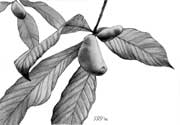 |
|||
|
Volume 12, Issue 37 ~ September 9-15, 2004
|
|||
|
|
 Way Down Yonder in the Pawpaw Patch Way Down Yonder in the Pawpaw PatchAhh, autumn, that mellow time of year. It’s the end of summer; school is back in session; baseball pennant races are heating up; the days are becoming noticeably shorter and cooler. At the beach, the water is still warm but the crowds are mostly gone. It’s also the time to wander on down to the pawpaw patch to gather one of North America’s most overlooked wild fruits. The fruit of the pawpaw is as sweet and rich as custard. About the size and shape of a small potato, they have thick green skin that develops brown spots and looks bruised when ripe. Inside, the pulp is a pale orange, and there are a number of large seeds. Pawpaw trees grow in clumps along flood plains and stream valleys where the soil is rich. They are small- to medium-sized trees with slender trunks. The large leaves grow to about 10 inches, with a narrow base gradually spreading out to a breadth of about six inches, then narrowing to an elongated point. The shape, which allows water to shed efficiently, is typical of trees that grow in the humid tropics, and the pawpaw is the northernmost relative of a large tropical family. After finding a pawpaw patch, you might have to carefully inspect many trees until you find one with fruit, which may be high up and out of reach. If you shake the tree, ripe fruit will fall with a thud. Pawpaws are heavy, so watch out that one doesn’t fall on your head. Many flowering trees produce colorful or sweet-smelling flowers that attract birds and butterflies, but pawpaws produce flowers that attract flies and beetles as pollinators. The flowers are dark maroon and emit a faint, rotten scent. This is consistent with other wild flowers that rely on such decomposer organisms to reproduce. This odd-seeming floral presentation might sound repulsive, but the flowers have an interesting shape and the unusual color is attractive. I seek them out in spring, making note to check the area for fruit in the fall. Pawpaw trees may have an advantage over other species in our deer-overpopulated woods. The leaves emit an oily scent and have a bitter taste that deer seem to find unpalatable. The twigs are a source of bio-active chemicals that scientists are using to develop botanical pesticides and anti-cancer medications. Many commercial nurseries have begun to promote the pawpaw as an attractive residential landscape tree because of its attractive growth form and fall color, the leaves turning a nice shade of yellow. Pawpaws are also the host plant to the caterpillar form of the beautiful zebra swallowtail butterfly. Pawpaws are delicious all by themselves, but the taste is so sweet and rich that some find the flavor a bit much, preferring to consume their pawpaws as an ingredient in a pie or pudding. In contrast to persimmons (another great wild fruit), I find that one or two pawpaws satisfies my appetite while I could eat persimmons for an hour. |
||
|
© COPYRIGHT 2004 by New Bay Enterprises, Inc. All rights reserved. |

